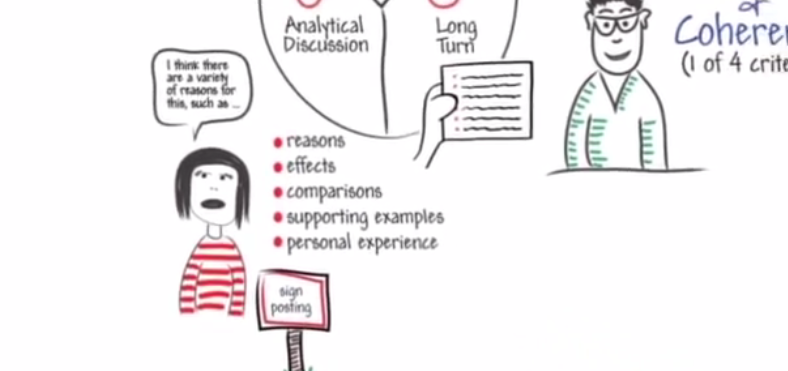(单词翻译:单击)
So you've decided to take the IELTS Exam, congratulations! Success starts with IELTS.
感谢选择报考雅思,这将成为你成功之路的起点。
The speaking test is divided into three sections: Part 1 is the introduction and general questions; Part 2 is the long turn and Part 3 is an analytical discussion.
雅思口语考试分为三个部分:第一部分是简介和一般性问题;第二部分是个人陈述;第三部分是分析性的问答讨论。
It's important to understand the criteria on which you will be tested in the IELTS exam.
明确雅思考试所采用的评分标准十分重要。
First we consider the criteria of fluency and coherence.This is one of four criteria on which you will be tested.
首先,我们来了解“流利性与连贯性”。这是口语部分四个评分标准之一。

We'll cover the other three in later videos.
我们将会在其他三个短片中分别介绍另外三项评分标准。
Fluency and coherence refer to your ability to speak at length, including organizing ideas logically and appropriately signposting.
流利性与连贯性指的是你在以下方面的能力:一是语言表达详尽的能力,包括符合逻辑地组织观点,以及进行适当的语义指示的能力。
It also refers to your ability to express and justify opinions, and to discuss and speculate about issues without long pauses or repetition of the same words.
流利性和连贯性还包含了表达观点、就你的见解进行辩护、就出现的话题进行讨论并推测的能力,并且,在表达过程中没有不自然的停顿或者重复使用相同的词。
Signposting is the use of words or phrases that indicate the direction of your thoughts.
语义指示是指在表达过程中使用可以表明你思维发展方向的词汇或者词组。
We will give you some examples of this in a moment.
我们会在稍后的部分举例说明。
Many students tried memorizing large portions of speech to repeat during the speaking test.
许多考生试图背诵大段的语篇,想在口语考试中进行套用。
But this can add unnecessary stress and sound unnatural. We don't recommend this approach.
但这其实会让你产生不必要的压力,听起来也不太自然。我们不建议你采用这种方式。
Here are a few tips to improve your speaking test performance.
接下来是一些建议,帮助你在口语考试中取得更佳表现。
As you are speaking about a topic, build on your point of view by adding a few details.
在针对一个话题进行表达的过程中,你需要在自己的观点中加入一些细节。
For example if the question is "What do you do?", rather than responding with “I am a teacher.”
例如,如果考官问What do you do?与其回答I am a teacher,
You might expand this to "I have been a high school mathematics teacher in New York for over five years."
不如将其扩展,"I have been a high school mathematics teacher in New York for over five years."(我在纽约一所高中当数学老师已经五年了。)
For Part 2 of the test, use the bullet points on the Task Card to help you structure a long turn and make notes in the one minute that given using keywords.
在口语考试的第二部分中,记得使用问题卡上的要点帮助自己组织个人陈述的内容,并要在一分钟准备时间内,使用关键词来做相应的笔记。
In Part 3 particularly, it is important to develop your answers and to speak at length.
在口语第三部分中,将你的答案进行扩展并详尽地表达十分重要。
You can do this by thinking of reasons, effects, comparisons, supporting examples and personal experience.
你可以思考以下方面:原因、后果、对比、支持性例证和个人经验。
Just make sure you are signposting what you say.
值得注意的是,在表达过程中应该针对内容进行语义指示。
For example, discussing excessive TV watching you might mention reasons:
例如,在讨论关于过度看电视这个话题时,你可能会涉及到原因,
increasing numbers of TV channels compared to a generation ago and the popularity of TV characters.
即与过去相比,电视频道增加了,电视人物的知名度也提高了
Effects: increasing obesity levels; eyesight problems and other health issues.
后果:肥胖程度增加、视力下降以及其他健康问题。
Experience: my nephew watches nothing except cartoons. He will not study.
个人经历:我的侄子沉迷于看动画片,根本无心学习。
Here are some examples of signposting for Part 3 of the test.
在口语第三部分中,你可以使用不同的语义指示。
Compare/contrast: in my view there are two main differences.
进行比较或者对比:in my view there are two main differences...
Responding to a point: Yes, I agree because...; or I'm not sure I agree with that, you see…
回应某个观点:Yes, I'd agree because...或者 I'm not sure I agree with that, you see…
Speculating on the future: I think we'll probably see a lot of... or Maybe there'll be more... or It's unlikely that we will have...
就未来进行推测:I think we'll probably see a lot out of... 或 Maybe there'll be more... 又或 It's unlikely that we will have...
Practice is the key to increasing your fluency. There are no shortcuts.
提高流利性的关键是加强练习,没有任何捷径可走。
Practice using English in everyday communication as much as you can.
你应该在日常交流对话中尽可能地练习使用英语。
Record yourself talking about different subjects, then play it back and listen for linking expressions,
你可以在谈论不同话题时录音,然后回放,寻找自己表述过程中的连接表达式
hesitation, words you may be repeating and times when your speech is slow.
是否磕巴、是否重复实用词汇、以及语速放慢的地方有几次等等。
This will help improve your fluency.The assessment criteria is the only thing on which you will be tested.
这个方法可以帮助你改善流利度。考试的评分标准是用以考核的唯一参照。
You will not be assessed on your appearance, body language while speaking in the exam or your creative ideas.
你的样貌打扮、考试过程中的肢体语言或者你提出的富有创意的观点都不在考核范围之内。
IELTS examiners are a very consistent with their application of the IELTS assessment criteria.
雅思考官在使用统一的评分标准方面保持高度的一致性。
It is the same assessment given everywhere in the country and everywhere in the world.
雅思考试在世界上任何国家所采用的评分标准都是相同的。
For more information, please see the other speaking test videos: lexical resources, grammatical ranging accuracy and pronunciation.
请查看其它雅思口语考试备考短片,了解另外三个评分标准:词汇多样性、语法多样性及准确性,以及发音。


